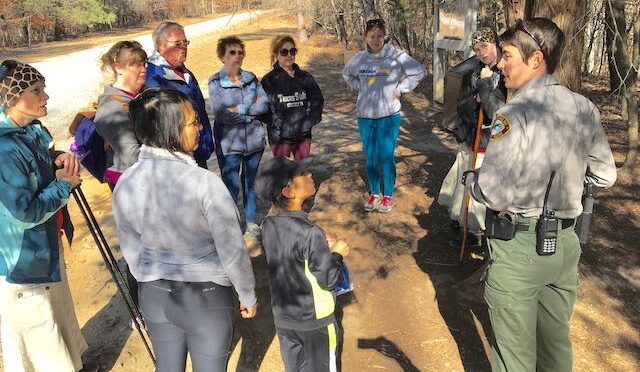We get out a lot. We’ve been getting out a lot for more than 30 years. During that time we’ve learned a thing or two. Nothing revolutionary, nothing that’s radically changed the sport. But maybe something you’ll find helpful, something you didn’t know that might help next time you’re on the trail. Something that will shorten your learning curve — though the learning never stops.
We’ve divided our tips into:
- Before the Hike. Tips on preparing and plannin
- During the Hike: Things you might find helpful on the trail
- Apres Hike: Little follow-ups to make your next hike (or the next day) even better
- Motivation! For when you don’t want to hike (but you know it will do you good)
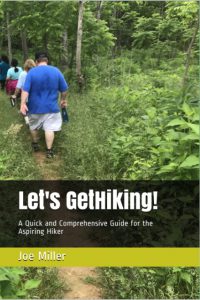 And if you’d like to find our tips in one place, check out our “Let’s GetHiking! A Quick and Comprehensive Guide (2nd Edition).” This 110-page guidebook goes over all the essentials for becoming a confident hiker. The expanded Second Edition includes sections on next-level hiking, including hiking at night, hiking in the rain, and hiking in summer’s heat. Check it out here.
And if you’d like to find our tips in one place, check out our “Let’s GetHiking! A Quick and Comprehensive Guide (2nd Edition).” This 110-page guidebook goes over all the essentials for becoming a confident hiker. The expanded Second Edition includes sections on next-level hiking, including hiking at night, hiking in the rain, and hiking in summer’s heat. Check it out here.
Enjoy!
Before the hike
Don’t hesitate
A simple tip for a perfect weather week: The temperatures are friendly, which they haven’t been in a while — take advantage! Don’t overthink it, don’t let chores get in the way. When the weather’s like this get out and hit the trail!
Be wary of guided hike descriptions
 On a hike last weekend a new hiker mentioned she’d recently hiked with a new Meetup group. The hike was described as being about 10 miles, which turned out to be true. It also said that some of the hike was off-trail. I knew the hike in question and started to laugh. “Yeah,” she said, “it was all off-trail.” And not easy, follow-an-old-roadbed off-trail, but rather scramble-up-rock-face-and-squeeze-through-briars off-trail. Fortunately, the hiker had a good sense of humor and was in good shape. But it was not the hike she expected.
On a hike last weekend a new hiker mentioned she’d recently hiked with a new Meetup group. The hike was described as being about 10 miles, which turned out to be true. It also said that some of the hike was off-trail. I knew the hike in question and started to laugh. “Yeah,” she said, “it was all off-trail.” And not easy, follow-an-old-roadbed off-trail, but rather scramble-up-rock-face-and-squeeze-through-briars off-trail. Fortunately, the hiker had a good sense of humor and was in good shape. But it was not the hike she expected.
How do you insure that a posted hike is what it says it is? Well, you can’t be absolutely certain, but you can do a little vetting. Some things to keep in mind:
- Do you recognize the hike leader(s)? It doesn’t take more than one outing to recognize whether a hike leader has a flair for understatement or hyperbole, or is a straight shooter.
- Check the comments for previous hikes lead by this person. Most folks aren’t shy about commenting if they think a hike wasn’t as advertised.
- Watch for key phrases. “Off-trail” is one of them; as our new hiker discovered, off-trail covers a lot of ground. “Stream crossings” is another: are there a couple of low-water rock-hops or are they roll-up-the-pant-legs-mid-thigh-to-stay-dry crossings?
- When in doubt … reach out. Dubious? Send the hike leader a message for clarification or additional information. Every hike posted should include distance and difficulty; the latter should include a brief justification for the rating. A response, or lack thereof, to your message will also tell you whether the hike leader is truly interested in leading a hike, or simply doesn’t want to hike alone.
You’re putting a lot of trust in the person leading the hike. You have a right to know what you’re getting into.
Scouting for dry trail? Try old roadbeds
Even when it’s dry, it’s wet. That seems to be the story of this winter: the sky may be sunny and inviting, but the trail, thanks to persistent rains and continued cold temperatures, remains downright soggy. Even with a couple days of midweek sun and warm temperatures, trails throughout the region will likely remain saturated this weekend.
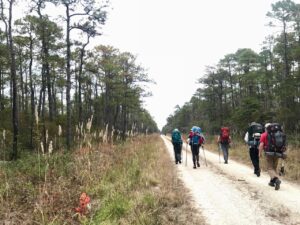 Most trails, that is.
Most trails, that is.
One exception: trails piggybacking on old roadbeds, especially old roadbeds not so long ago decommissioned. These trails were designed with durability and reliability in mind. Whether you needed to haul your farm goods to market or get your timber off the mountain, you couldn’t afford roads that quickly succumbed to rain. These roads may not have been designed with scenery in mind, but isn’t sacrificing an overlook here, a waterfall there worth it to finally emerge from a hike with dry feet?
How to find such a hike? Likely, you’ve been on these doublewide trails before; take a moment and you can likely conjure up one or two. Also: website trail descriptions may mention if the trail is on old roadbed; you can also call the ranger’s office and ask.
Shoulder season gear check
We’re entering one of those times of year when one weekend we may be hiking in shorts, the next we’re bundled up like Nanook. That means you need to be extra diligent when packing for a hike. This is especially true if the temperature was in the 60s for your last hike and your upcoming hike will be in the 30s. Odds are good you jettisoned extra layers, gloves, hat and other cold-weather-specific gear for that 60-degree outing. You might have even downsized your pack. You’ll want to make darn sure you’re prepared for the cold when you head back out into freezing temps. Keeping a checklist near your gear box helps, as does simply taking an extra five minutes before heading out to think through the conditions (How cold will it be? Will it be wet? What about my head and hands? etc.), then make sure you have the appropriate gear.
Keep a day-pack box

Do have different day packs for different occasions? A light-weight pack for short hikes, say, or hikes in the summer? A heftier pack for winter? A fanny pack for those days when you’re feeling fast? The question is especially relevant now that Daylight Saving Time opens the option for quick getaway evening hikes, requiring minimal gear, in addition to your longer weekend hikes, which require more water, food, a change of clothes, etc.
Rather than keep all your packs fully stocked, Have a dedicated box where you keep your daypack essentials. When you head out on a hike, grab your bag de jour and load it with what you need. It’s an extra step, but it won’t take long. And it will greatly minimize the odds of discovering, at an inopportune time, that you’re missing a vital piece of equipment.
Check the forecast
We’ve hit that time of year when you can head out on an afternoon hike in 70-degree shorts weather and finish with the temperature dipping into the 50s. Add to that an earlier-and-earlier setting sun and you could develop quite a chill by hike’s end (especially if you worked up a little sweat during those warmer hours). Conversely, if you’re a morning hiker you could start in the 40s and, if you haven’t layered appropriately, wind up overheated by hike’s end. Checking the forecast just takes a minute; invest the time before heading out.
Beware the holiday hiker
You’ll need to start picking your hikes more wisely now that we’re entering the holiday season. As we note below (see “Resources”), trail traffic is bound to pick up, especially this weekend and the period between Christmas and the end of the year. These will generally be occasional hikers, hikers looking for shorter trails, for trailheads with addresses, trailheads with facilities, especially Visitor Centers and, heaven forbid, a gift shop. Avoid any of those and you’ll likely have the trail to yourself.
What’s in my day pack?
Little knives
 In the past week I’ve found two small knives; one, a mini Swiss Army knife, the other a tiny True single blade. The discoveries made me think about all the times I’ve been without a knife on the trail and could have used one, even a teensy one. The problem: two many packs, not enough knives. Because I’m not organized enough to relocate gear from pack to pack before heading out on a hike, I need to keep each pack fully stocked. And that includes these little godsend knives. Little knives: keep ‘em handy.
In the past week I’ve found two small knives; one, a mini Swiss Army knife, the other a tiny True single blade. The discoveries made me think about all the times I’ve been without a knife on the trail and could have used one, even a teensy one. The problem: two many packs, not enough knives. Because I’m not organized enough to relocate gear from pack to pack before heading out on a hike, I need to keep each pack fully stocked. And that includes these little godsend knives. Little knives: keep ‘em handy.
Skurka on navigation tools
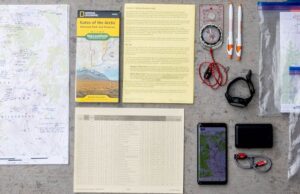 This is from the Facebook page of Andrew Skurka, one of the premier adventurers and guides of today. Follow him here.
This is from the Facebook page of Andrew Skurka, one of the premier adventurers and guides of today. Follow him here.
An expert navigator hikes with three things:
- A toolkit, pictured, which includes three types of maps (large-scale, small-scale, and digital), a magnetic compass, timepiece, altimeter, GPS, and a pen. These items can be purchased or downloaded, and should be considered a starting point.
- Skills and knowledge, to use these tools effectively and efficiently. This can be gained by reading, watching, and practicing in clinical settings.
- Experience, so that past learnings and observations can be extrapolated to new circumstances and settings. For example, knowing the tool(s) that work best in a particular location, finding an elk trail through thick brush, determining if a pass will “go” based on the contour lines, or approximating the size of a creek that must be forded. This is really what separates intermediate navigators from experts, and it requires time in the field and attentiveness.
Crowd alert
As we head into the busy fall hiking season, remember that you aren’t the only one who loves hiking this time of year. Everyone loves being outdoors when the temperature is 70 degrees, the humidity is 20 percent and there’s nary a cloud in the sky. Thus, we reiterate our advice on how to avoid crowds:
- Before heading out, check the venue’s website/social media to see if they have any advisories on crowds (e.g., you may have to wait a spell to find a parking space).
- Certain trailheads attract the casual hiker, including those with:
- Paved parking
- Restrooms
- Visitor center
- An address you can plug into a GPS device
You may not avoid crowds entirely, but you won’t be hiking elbow to elbow.
Check ahead
Hurricanes/tropical storms/depressions that hang out in your region for several days dropping buckets of rain have a tendency to make trails wet. Close them, even. Even the mere thought of a big “weather event” can close trails. As of Tuesday, before a drop of Debbie had hit, seven North Carolina State Parks announced they would close starting Wednesday and lasting at least through Friday. Too much rain isn’t good for trails, and as a result, they can be closed. Th point: this weekend, before heading out, check ahead to make sure the trail you hope to hike is open.
Pack an antihistamine
 We’re into the spring pollen season, which can be miserable for lots of outdoors folks: stuffy nose, runny eyes, clogged head. Some of you are no doubt aware of your allergies. But allergies can come on without warning, leaving the unsuspecting stumbling down the trail in a sea of … congestion. Buy a small bubble pack of pills, add ‘em to your first aid kit and you’ll be prepared.
We’re into the spring pollen season, which can be miserable for lots of outdoors folks: stuffy nose, runny eyes, clogged head. Some of you are no doubt aware of your allergies. But allergies can come on without warning, leaving the unsuspecting stumbling down the trail in a sea of … congestion. Buy a small bubble pack of pills, add ‘em to your first aid kit and you’ll be prepared.
Follow directions to the trailhead!
You’ve signed up for a group hike, the hike leader posts the trailhead location; these days, that more than likely includes an address. An actual street address, which is a good thing because it can lead you directly to the trailhead, which is where, again, the hike starts. So why, then, do so many people get in their car, disregard the hike leader’s instructions, and instead plug in the name of the trail or park? The problem? Trails often have several trailheads, parks even more. As a hike leader, there’s nothing like having the group assembled and ready to go, and getting a call from a late hiker who says, “I’m here but no one else is.” Argh!
Use the address you’re given, period.
Pack a phone battery power bank
 If you’ve ever read an advisory on something you buy and think “This is ridiculous! Who would do such a thing?” your next thought was likely, “Of course, there must be a reason they put it here.” That’s the set-up for today’s tip: Buy a power bank for charging your phone at the campsite, rather than plugging it into your car and letting it charge for a half hour — while the car is running. This weekend on a camping trip, I walked by a car with the motor running. Didn’t think much about it, just assumed someone had either just arrived or was getting ready to leave (tinted windows, it was hard to tell). About 20 minutes later I walked by and the car was still running. I walked down to where the campers were lounging about: “Hey, someone left their car running.” Instead of someone jumping to their feet and dashing to turn if off while exclaiming, “Golly, I can’t believe I did that,” the response was, “That’s mine. I’m charging my phone.” At $4.89 a gallon, there are cheaper ways. Namely, a portable power bank.
If you’ve ever read an advisory on something you buy and think “This is ridiculous! Who would do such a thing?” your next thought was likely, “Of course, there must be a reason they put it here.” That’s the set-up for today’s tip: Buy a power bank for charging your phone at the campsite, rather than plugging it into your car and letting it charge for a half hour — while the car is running. This weekend on a camping trip, I walked by a car with the motor running. Didn’t think much about it, just assumed someone had either just arrived or was getting ready to leave (tinted windows, it was hard to tell). About 20 minutes later I walked by and the car was still running. I walked down to where the campers were lounging about: “Hey, someone left their car running.” Instead of someone jumping to their feet and dashing to turn if off while exclaiming, “Golly, I can’t believe I did that,” the response was, “That’s mine. I’m charging my phone.” At $4.89 a gallon, there are cheaper ways. Namely, a portable power bank.
Wear a Buff
 Twice a year we endorse the Buff, that stretch tube of microfibre fabric that can be worn a dozen ways — as ear muffs, as cowl, as hat, as balaclava, as blindfold for a nice nap on a sunny day. Most of those are winter adaptations. Come summer, the Buff makes a dandy lightweight headband to help you keep the sweat out of your eyes. When you enter a meadow or other clearing, pull it over the top of your head to protect your head from sunlight. And when you hit a cool creek? Dip it in the water and give yourself — your face and neck in particular, a cooling bath. Encounter a sandstorm? You get the picture. Check it out here.
Twice a year we endorse the Buff, that stretch tube of microfibre fabric that can be worn a dozen ways — as ear muffs, as cowl, as hat, as balaclava, as blindfold for a nice nap on a sunny day. Most of those are winter adaptations. Come summer, the Buff makes a dandy lightweight headband to help you keep the sweat out of your eyes. When you enter a meadow or other clearing, pull it over the top of your head to protect your head from sunlight. And when you hit a cool creek? Dip it in the water and give yourself — your face and neck in particular, a cooling bath. Encounter a sandstorm? You get the picture. Check it out here.
Clear, cool, water
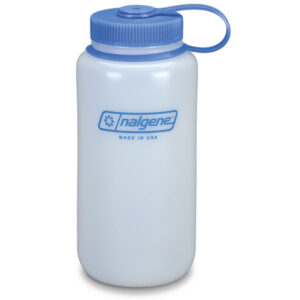 Especially this time of year, no matter how short the hike, you need to remember to take water and drink. Unfortunately, in warm weather when you need to drink the most you may feel like doing it the least as you take a slug of tepid water better suited for brewing tea than quenching thirst. To keep hydration refreshing, try filling your water bottle three-quarters full the night before a hike and stick it in the freezer. The next morning, top off this block of ice with water. If you’re using a bladder, fill it with ice cubes the morning of a hike, then top off with cold water. Either way, you should have cool, tasty water for a good two hours.
Especially this time of year, no matter how short the hike, you need to remember to take water and drink. Unfortunately, in warm weather when you need to drink the most you may feel like doing it the least as you take a slug of tepid water better suited for brewing tea than quenching thirst. To keep hydration refreshing, try filling your water bottle three-quarters full the night before a hike and stick it in the freezer. The next morning, top off this block of ice with water. If you’re using a bladder, fill it with ice cubes the morning of a hike, then top off with cold water. Either way, you should have cool, tasty water for a good two hours.
Follow the forecast (but don’t freak over it)
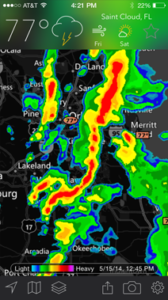 Last Saturday, the forecast for this weekend’s GetBackpacking! trip to Standing Indian indicated rain on Friday and Saturday; come Monday it was down to just Friday. Tuesday, showers Friday morning only. Wednesday, no rain. I learned a while back not to pull the plug on a trip too soon. A week out, you’re looking at a guess. Five days out, a slightly more educated guess. Two days out: OK, maybe I’ll plan my wardrobe and gear accordingly. Even the morning of, sure, check the forecast, but pay more attention to the radar. Above all, keep an eye on the sky the entire time you’re on the trail.
Last Saturday, the forecast for this weekend’s GetBackpacking! trip to Standing Indian indicated rain on Friday and Saturday; come Monday it was down to just Friday. Tuesday, showers Friday morning only. Wednesday, no rain. I learned a while back not to pull the plug on a trip too soon. A week out, you’re looking at a guess. Five days out, a slightly more educated guess. Two days out: OK, maybe I’ll plan my wardrobe and gear accordingly. Even the morning of, sure, check the forecast, but pay more attention to the radar. Above all, keep an eye on the sky the entire time you’re on the trail.
Take extra food
 Backpack enough and you get a pretty good idea of exactly how much food you’ll need on a trip. Backpack enough and you’ll also realize there’s no sense in toting extra weight. Over the years, I’ve come to pride myself in ending a trip with only a crumb or two in my back. Our encounter over the weekend with the Virginia Creepers (see post above) made me realize the folly of this approach: You run into folks in need on the trail, of course you’re going to help them out. Plus, there’s always the possibility that weather or other circumstances could extend your trip an extra day — or longer. From now on, I’m packing extra food.
Backpack enough and you get a pretty good idea of exactly how much food you’ll need on a trip. Backpack enough and you’ll also realize there’s no sense in toting extra weight. Over the years, I’ve come to pride myself in ending a trip with only a crumb or two in my back. Our encounter over the weekend with the Virginia Creepers (see post above) made me realize the folly of this approach: You run into folks in need on the trail, of course you’re going to help them out. Plus, there’s always the possibility that weather or other circumstances could extend your trip an extra day — or longer. From now on, I’m packing extra food.
Be smart, be flexible
Have a plan, but don’t be afraid to change it. Maybe you’d been planning a long day on the trail for weeks, but that plan didn’t take into account a last-minute heatwave. You can still get out, just take a shorter hike. Cooler days lie ahead for that long day on the trail, a day you’ll enjoy so much more without suffering heat stroke.
Pack extra socks
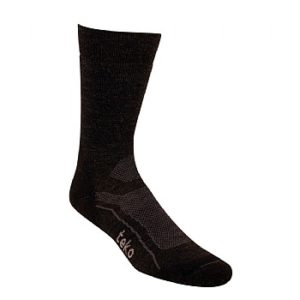
It’s hot. You start to sweat. Your feet sweat. Your wool socks do a good job of wicking away the moisture — initially, at least. But even if they stay a little damp, they can be a blister liability. Avoid the wet-sock syndrome by packing an extra pair. You start to feel your feet slipping around, stop and swap out your socks. Use your compression straps to tie your damp socks to the outside of your daypack. They stand a better chance of drying there — and they won’t funkify your lunch and whatever else may be in your pack.
Drill down on that temperature
You look at the forecast, it says the high will be 55. Yay, you think, I might just get away with a light long sleeve for my hike. Trouble is, that high won’t hit until mid-afternoon, and your hike begins at 9 a.m., when it will be just above freezing. Big difference between 35 and 55: make sure you’re checking the forecast for when you’ll be hiking.
On the trail
On hot days, slow it down
 There’s a segment of the hiking community that hikes at a brisk pace, even when the temperature is anything but brisk. The latter would describe summer hiking; the former would be wise to recognize as much. For when the going gets hot, the pace should start slowing. Recognize that the heat takes it out of you, recognize that even at two-thirds your normal pace you’re getting a good workout, recognize that bad things can happen when you overheat. Accept the realities of summer by dialing it back a bit. And, as the photo suggests, remember to take more frequent breaks.
There’s a segment of the hiking community that hikes at a brisk pace, even when the temperature is anything but brisk. The latter would describe summer hiking; the former would be wise to recognize as much. For when the going gets hot, the pace should start slowing. Recognize that the heat takes it out of you, recognize that even at two-thirds your normal pace you’re getting a good workout, recognize that bad things can happen when you overheat. Accept the realities of summer by dialing it back a bit. And, as the photo suggests, remember to take more frequent breaks.
Let those dogs breath on long hikes
For many of us, summer means long hikes on mountain trails, long hikes that are inclined to raise blisters. One way to keep that from happening is to take off your shoes and socks when you take a break. That lets your feet cool and gives your shoes and socks a chance to dry out. Heat and friction aided by moisture: to key elements of blister cultivation. Learn more tips for avoiding blisters on the trail from the Gearjunkie, here.
Scouting for dry trail? Try old roadbeds
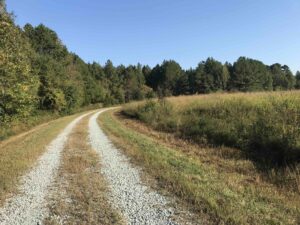 Even when it’s dry, it’s wet. That seems to be the story of this winter: the sky may be sunny and inviting, but the trail, thanks to persistent rains and continued cold temperatures, remains downright soggy. Even with a couple days of midweek sun and warm temperatures, trails throughout the region will likely remain saturated this weekend.
Even when it’s dry, it’s wet. That seems to be the story of this winter: the sky may be sunny and inviting, but the trail, thanks to persistent rains and continued cold temperatures, remains downright soggy. Even with a couple days of midweek sun and warm temperatures, trails throughout the region will likely remain saturated this weekend.
Most trails, that is.
One exception: trails piggybacking on old roadbeds, especially old roadbeds not so long ago decommissioned. These trails were designed with durability and reliability in mind. Whether you needed to haul your farm goods to market or get your timber off the mountain, you couldn’t afford roads that quickly succumbed to rain. These roads may not have been designed with scenery in mind, but isn’t sacrificing an overlook here, a waterfall there worth it to finally emerge from a hike with dry feet?
How to find such a hike? Likely, you’ve been on these doublewide trails before; take a moment and you can likely conjure up one or two. Also: website trail descriptions may mention if the trail is on old roadbed; you can also call the ranger’s office and ask.Scouting for dry trail? Try old roadbeds
Even when it’s dry, it’s wet. That seems to be the story of this winter: the sky may be sunny and inviting, but the trail, thanks to persistent rains and continued cold temperatures, remains downright soggy. Even with a couple days of midweek sun and warm temperatures, trails throughout the region will likely remain saturated this weekend.
Most trails, that is.
One exception: trails piggybacking on old roadbeds, especially old roadbeds not so long ago decommissioned. These trails were designed with durability and reliability in mind. Whether you needed to haul your farm goods to market or get your timber off the mountain, you couldn’t afford roads that quickly succumbed to rain. These roads may not have been designed with scenery in mind, but isn’t sacrificing an overlook here, a waterfall there worth it to finally emerge from a hike with dry feet?
How to find such a hike? Likely, you’ve been on these doublewide trails before; take a moment and you can likely conjure up one or two. Also: website trail descriptions may mention if the trail is on old roadbed; you can also call the ranger’s office and ask.
Bridge freezes before trail surface
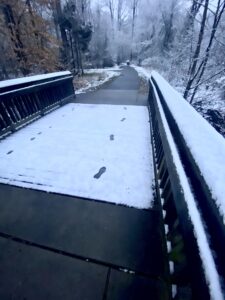 A reminder based on our recent freezing rain and snow that while the trail may just be wet, perhaps a little slushy, from snow or freezing rain, the footbridges you cross may be surprisingly slick. The reason: cold air surrounds an exposed bridge surface, causing the cold to be felt from both above and below. Thus, always approach a footbridge with care, even though conditions on the trail seem safe.
A reminder based on our recent freezing rain and snow that while the trail may just be wet, perhaps a little slushy, from snow or freezing rain, the footbridges you cross may be surprisingly slick. The reason: cold air surrounds an exposed bridge surface, causing the cold to be felt from both above and below. Thus, always approach a footbridge with care, even though conditions on the trail seem safe.
You back there?
On a group hike, where the hikers are expected to hang together, you have one responsibility: the hiker directly behind you. If you suddenly notice there’s no one behind you, alert the head of the pack — or at least the person in front of you (the word, hopefully, will make it up the line). Stop and give the hiker(s) behind you a moment to catch up. If they don’t after a short period, head back down the trail to make sure there’s not a problem.
Wet trail shoes
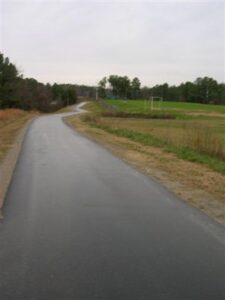 Even if you hit a dry spell among our recent rains, don’t assume the trail you’re headed to will be dry. The cold that’s followed most recent rains has kept the earth from drying out; thus, a fair amount of that moisture remains. At the least, you might want to rethink those lightweight trail runners and stick with your heavy-duty hikers, at least for a bit longer.
Even if you hit a dry spell among our recent rains, don’t assume the trail you’re headed to will be dry. The cold that’s followed most recent rains has kept the earth from drying out; thus, a fair amount of that moisture remains. At the least, you might want to rethink those lightweight trail runners and stick with your heavy-duty hikers, at least for a bit longer.
Three points of contact

A lot of folks who use trekking poles don’t reap the full benefits of their sticks. Case in point: poles can be lifesavers for maintaining balance on uneven terrain or when rock-hopping a creek. The key to making your poles work in such conditions? Always maintain three points of contact. If one foot is up, make sure the other is on the ground, as are your poles. If one stick is up, the other stick and both feet should be down. A tripod is more stable than a bipod. Keep this in mind, especially when crossing a creek, especially when navigating rocky or eroded trail.
Double blaze defined
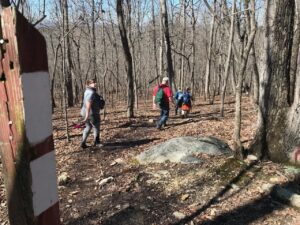 You’re hiking along on a blazed trail, let’s say a trail blazed with a white dot. You follow these single white dots for a bit, then, suddenly you come upon a tree with two dots, one atop the other. Perplexed? This double marking indicates that the trail takes a turn. Now, ideally, the upper blaze will be offset to the left or right — this indicates the direction the trail heads: if it’s off to the left, the trail veers left, off to the right it veers right. This isn’t always the case: sometimes you’ll see the two blazes in a vertical line. In that case, check both right and left to see which way the trail veers. If the trail has been properly marked you should be able to see another blaze down the appropriate path.
You’re hiking along on a blazed trail, let’s say a trail blazed with a white dot. You follow these single white dots for a bit, then, suddenly you come upon a tree with two dots, one atop the other. Perplexed? This double marking indicates that the trail takes a turn. Now, ideally, the upper blaze will be offset to the left or right — this indicates the direction the trail heads: if it’s off to the left, the trail veers left, off to the right it veers right. This isn’t always the case: sometimes you’ll see the two blazes in a vertical line. In that case, check both right and left to see which way the trail veers. If the trail has been properly marked you should be able to see another blaze down the appropriate path.
A seasonal reminder to drink (water)
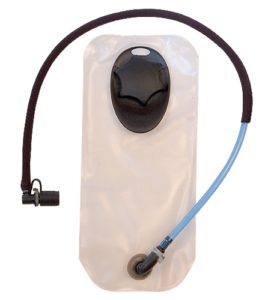
With temperatures flirting with the upper 70s, it’s time for our periodic nag about remembering to hydrate. Reasons to drink on the trail: getting dehydrated not only is dangerous to your health, making you subject to heat stroke, it’ll slow you down, make you crabby, and basically take the fun out of your hike. Sometimes, the trick to staying hydrated is simply wanting to drink. We find that on a hot day, our urge to drink tepid water is lukewarm at best. So: if you drink from a water bottle, fill it three quarters full the night before a hike, stick it in the freezer. In the morning, before heading out, top the bottle off with water. If you’re a bladder enthusiast, fill your bladder with ice, then top off with water. In both instances, you should have cold water for at least two hours on even the hottest day. So, no excuses — drink!
Airplane mode, please
 We were hiking in peace, then someone’s phone started hooting. “Got a signal!” he yelled, and immediately the peace was broken as every alert the hiker had accrued in our valley dead zone made itself heard. Most of us are outdoors to disconnect. If you can’t bear to be out of contact, at least silence your alerts and go to vibration mode: not everyone needs to know that Amazon has delivered your shoulder dolly moving straps.
We were hiking in peace, then someone’s phone started hooting. “Got a signal!” he yelled, and immediately the peace was broken as every alert the hiker had accrued in our valley dead zone made itself heard. Most of us are outdoors to disconnect. If you can’t bear to be out of contact, at least silence your alerts and go to vibration mode: not everyone needs to know that Amazon has delivered your shoulder dolly moving straps.
Park smart
 Spring, a time when our fancies, for seemingly all of us, turn to hiking. Among other things, that can translate into congested trailhead parking. A reminder that when you pull up to a parking area, especially a gravel lot or a roadside pullout, be aware that you likely won’t be the only person hiking from this location. If it’s a lot, think about the best way to park that will allow the most cars: for instance, if you’re the first car, park at one end or the other, allowing enough space for you to get in and out, but not enough space that you eat up a potential parking spot. Likewise with roadside parking. Take a moment to think about your fellow hikers and their parking needs.
Spring, a time when our fancies, for seemingly all of us, turn to hiking. Among other things, that can translate into congested trailhead parking. A reminder that when you pull up to a parking area, especially a gravel lot or a roadside pullout, be aware that you likely won’t be the only person hiking from this location. If it’s a lot, think about the best way to park that will allow the most cars: for instance, if you’re the first car, park at one end or the other, allowing enough space for you to get in and out, but not enough space that you eat up a potential parking spot. Likewise with roadside parking. Take a moment to think about your fellow hikers and their parking needs.
Snakes: Leave ‘em be
 We were a mile into a hike in the 40,000-acre Butner Game Land when one of our hikers spotted a snake sunning up ahead on the exposed double-track trail. We gathered for a look after determining it wasn’t harmful; that was my main concern. But my other main concern was that we do no harm to the snake. “OK, have a look, then move on,” I advised the dozen hikers in the group. That prompted several to go for their smartphone cameras and lean in for a shot. “OK, quick shot, then let’s get going. He’s just trying to jump-start his engine” (it was in the low 50s, a bit cool for his type, but it was sunny and it was April 10, for Pete’s sake). “We don’t want to stress him,” which prompted one hiker to reach toward the reptile. “Don’t!” I said. Captive snakes may get used to human touch and not mind it, but wild ones apparently don’t relish the experience. Admire from a distance, then move in.
We were a mile into a hike in the 40,000-acre Butner Game Land when one of our hikers spotted a snake sunning up ahead on the exposed double-track trail. We gathered for a look after determining it wasn’t harmful; that was my main concern. But my other main concern was that we do no harm to the snake. “OK, have a look, then move on,” I advised the dozen hikers in the group. That prompted several to go for their smartphone cameras and lean in for a shot. “OK, quick shot, then let’s get going. He’s just trying to jump-start his engine” (it was in the low 50s, a bit cool for his type, but it was sunny and it was April 10, for Pete’s sake). “We don’t want to stress him,” which prompted one hiker to reach toward the reptile. “Don’t!” I said. Captive snakes may get used to human touch and not mind it, but wild ones apparently don’t relish the experience. Admire from a distance, then move in.
Don’t be a lemming
 Sometimes on a group hike we follow lemming-like the person in front of us. They can see, they must be paying attention and choosing the right path. And usually, they are — but not always. If you find yourself stepping on one-too-many wobbly rocks or into more puddles than seems necessary, it’s time to assume the lead. How, without offending the offending leader? Stop the hike by calling to attention something along the trail. Then, as everyone clusters around to ooh and ahh (or possibly huh?), subtly position yourself at the head of the pack. The “leader” likely won’t notice and even more likely won’t resent relinquishing the lead. Resume the hike — and be darn sure you pay attention!
Sometimes on a group hike we follow lemming-like the person in front of us. They can see, they must be paying attention and choosing the right path. And usually, they are — but not always. If you find yourself stepping on one-too-many wobbly rocks or into more puddles than seems necessary, it’s time to assume the lead. How, without offending the offending leader? Stop the hike by calling to attention something along the trail. Then, as everyone clusters around to ooh and ahh (or possibly huh?), subtly position yourself at the head of the pack. The “leader” likely won’t notice and even more likely won’t resent relinquishing the lead. Resume the hike — and be darn sure you pay attention!
Feel with your feet
As we enter the peak fall color, leaves will shortly begin to fall and cover the trail. Even on a well-blazed trail the accumulating leaf litter can make it difficult to keep the trail. Your best bet for staying on trail? Feel your feet. The leaves provide only a light coating over the trail: as long as you’re still on the trail, it will feel firm on the compacted ground beneath. As soon as you stray, however, your steps will become more cushioned and you’ll sink into the earth as you leave the compacted trail. When that happens, stop and look for a blaze: in front of you at first, behind you if you don’t see one straight ahead. If you catch your error soon enough, you shouldn’t have trouble regaining the trail.
Eventide: take a 10-minute break
Dusk. Twilight. Eventide. Gloaming. All describe a great time to be out on the porch watching day fade to night. Not such a great time to be on the trail, however. This in-between time, this time when there’s not quite enough light to see by — especially to see roots and rocks in the trail — yet it’s not dark enough to benefit from igniting your headlamp, is a challenging time on the trail. For many of us it’s a nerve-wracking passage between the clarity offered by the sun and the focus provided by a good headlamp. So why deal with it, especially if you’ve got another mile or more to hike? Rather, it’s a good time to take a 10-minute break — about the time it takes for the gloaming period to pass. Drink some water, have a snack — and enjoy nature’s shift change, when the diurnal head home for the night, the nocturnal punch in for their shift.
Four fingers ’til sundown
Sounds like an old west thriller starring Clint Eastwood, Buddy Van Horn and that guy with the googly eyes, right? Rather, it’s woodsy talk for “an hour ’til sundown.” It’s an old backwoods skill for estimating how much time until the sun sets that involves — well, rather than tell you we’ll show you, with the graphic on the right from the folks at Manliness. It’s pretty reliable, too, provided you can find a spot in this neck of the woods with a clear shot of both the sun and the western horizon.
Motivation!
Get out!
 After a long, cold winter, it’s easy to feel sluggish coming off the couch and getting back on the trail. Especially when you have a tease of a springlike weekend, as we had this past weekend, then have it rescinded, as we’re experiencing this week. But here’s the thing: Spring officially arrived Tuesday night; Spring and Fall are arguably the best two times of year to hike. You don’t have the luxury of moping and waiting for perfect weather. Commit to breaking through your lethargy and hitting the trail this weekend. Sunday is looking a little better (drier) than Saturday, so commit, now. Decided to hike one of your favorite trails. Maybe a trail you haven’t hiked in a while. Or a trail where you know, based on previous experience, Spring will be in bloom. Cement your commitment by pulling your gear together — now! — and keeping it handy. Start building anticipation for a day — or at least a half day — on the trail. It’s time to come out of hibernation.
After a long, cold winter, it’s easy to feel sluggish coming off the couch and getting back on the trail. Especially when you have a tease of a springlike weekend, as we had this past weekend, then have it rescinded, as we’re experiencing this week. But here’s the thing: Spring officially arrived Tuesday night; Spring and Fall are arguably the best two times of year to hike. You don’t have the luxury of moping and waiting for perfect weather. Commit to breaking through your lethargy and hitting the trail this weekend. Sunday is looking a little better (drier) than Saturday, so commit, now. Decided to hike one of your favorite trails. Maybe a trail you haven’t hiked in a while. Or a trail where you know, based on previous experience, Spring will be in bloom. Cement your commitment by pulling your gear together — now! — and keeping it handy. Start building anticipation for a day — or at least a half day — on the trail. It’s time to come out of hibernation.
Explore your North Carolina State Trails
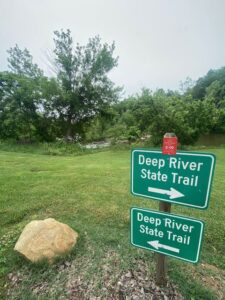 Tired of spring’s crowded trails? Then check out one of North Carolina’s State Trails. Granted, some — Wilderness Gateway, Equestrian — are still conceptual at this point. And some — the Mountains-to-Sea Trail, Fonta Flora State Trail — do have stretches that see some traffic. But for the most part, the State Trails are hidden gems. We invite you to discover that this weekend on the Deep River State Trail hike in Franklinville. This 3-mile out-and-back hike is on an old rail bed that’s well shaded and offers glimpses of some of the Deep’s rockier, more rollicking stretches. Learn more about that hike and sign up here.
Tired of spring’s crowded trails? Then check out one of North Carolina’s State Trails. Granted, some — Wilderness Gateway, Equestrian — are still conceptual at this point. And some — the Mountains-to-Sea Trail, Fonta Flora State Trail — do have stretches that see some traffic. But for the most part, the State Trails are hidden gems. We invite you to discover that this weekend on the Deep River State Trail hike in Franklinville. This 3-mile out-and-back hike is on an old rail bed that’s well shaded and offers glimpses of some of the Deep’s rockier, more rollicking stretches. Learn more about that hike and sign up here.
To help you explore more of our State Trail system, in coming weeks we’ll be highlighting some of our favorite stretches of the lesser-known trails, as well as some lesser-known sections of the more popular trails.
Play hooky
For the past week we’ve had a run of perfect weather: dry, cloudless skies, temperatures in the 60s, a tinge of emerging color. OK, so there was a hurricane in there. By and large, though, this is the weather we dream of. Weather that is ideal for getting out on the trail — and not being cooped up inside. Yes, we all have commitments. And it’s not like you need to throw your entire life out the window and become a vagabond (although … ). But slipping out for an hour, even just once a week, could result in a memory of the season that will help get you through the lean times (that is, the cold, rainy days of winter). Something to think about as you stare out the window … .
Trouble? Toot thrice
You may not have noticed this, but very likely on the sternum strap of your pack (the strap across your chest) one of the buckles has a fluted end king up to you. Take a close look: it’s a whistle. Oh? Oh, so it is! It’s not there to annoy other hikers; it’s there in case you get in trouble. If you are in trouble — if you’ve fallen, if you may have broken something, if you’re having an allergic reaction — three quick blasts lets anyone in earshot know you need help. If you hear, three whistles, give a signal toot on your whistle to let the distressed party know their signal has been heard. It’s wise for the distressed hiker to continue issuing three toots to help the searching party figure out where to go.
Three points of contact
A lot of folks who use trekking poles don’t reap the full benefits of their sticks. Case in point: poles can be lifesavers for maintaining balance on uneven terrain or when rock-hopping a creek. The key to making your poles work in such conditions? Always maintain three points of contact. If one foot is up, make sure the other is on the ground, as are your poles. If one stick is up, the other stick and both feet should be down. A tripod is more stable than a bipod. Keep this in mind, especially when crossing a creek, especially when navigating rocky or eroded trail.
Apres Hike
Before you wash those hiking duds …
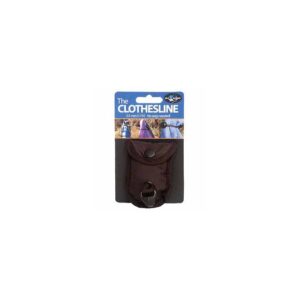 You’ve returned from a great weekend in the mountains — with the dirty, smelly clothes as proof. Before you blindly toss every smelly item in the wash, give ‘em the once over. Check your pockets to make sure, say, your Leatherman isn’t still aboard. That map in your back pocket won’t fair well in in the hot-water cycle, and the change from that life-saving soda-and-chips you scored at the mom-n-pop grocery on your way out will drive everyone nuts in the spin cycle. Be particularly thorough with those socks; if you had a blister-fest it’s unlikely that all the Band-Aids and moleskin withdrew with your feet.
You’ve returned from a great weekend in the mountains — with the dirty, smelly clothes as proof. Before you blindly toss every smelly item in the wash, give ‘em the once over. Check your pockets to make sure, say, your Leatherman isn’t still aboard. That map in your back pocket won’t fair well in in the hot-water cycle, and the change from that life-saving soda-and-chips you scored at the mom-n-pop grocery on your way out will drive everyone nuts in the spin cycle. Be particularly thorough with those socks; if you had a blister-fest it’s unlikely that all the Band-Aids and moleskin withdrew with your feet.
Most of all, search for tissues. Miss even one and you could be looking at a long evening plucking fluffs of white from every article of clothing on the trip.
Check. It just takes a second.
